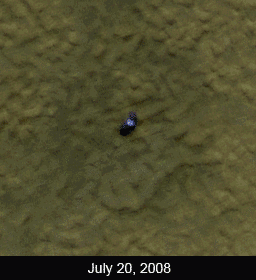HiRISE sees Phoenix in the Martian spring

Written by
Emily Lakdawalla
October 28, 2009
These Mars Reconnaissance Orbiter HiRISE images of the defunct Phoenix lander in the early dawn light of northern spring have been out for some time, but no one had accomplished the difficult task of locating the Phoenix hardware in them until this week. I took one look at the grainy-looking images and decided not to expend the effort on the search, figuring that if I waited long enough, someone else would do it! Thankfully Phil Stooke undertook the search and located the lander.
For context, here's a HiRISE photo of the landing site taken in the middle of the mission, around sol 55.

And here's one taken shortly after Phoenix quit communicating with Earth. It is cropped to exactly the same area as the first, so you can blink back and forth between them if you want to. There is no obvious difference at the lander, but the parachute seems to have blown around a bit in the intervening weeks.

Finally, here are the two views that HiRISE managed to get of the lander before going into safe mode on August 26.

Before you look at the photos too closely, let me caution you against overinterpreting them. There's a lot of light areas and dark areas. Light areas could possibly be frost, but realize that the lighting geometry in this image is really extreme: the Sun had only crawled to one degree above the horizon when HiRISE snapped these photos. (I feel I should pause here to recognize how awesome it is that HiRISE even managed to get images showing anything intelligible under such low light.) I've been babbling a lot lately about how such extreme lighting geometry brings out very subtle topographic features in Saturn's rings; the same effect holds in these images, so that the subtly hummocked Martian polar landscape will suddenly seem like it's covered with mountainous ridges and valleys. I don't have any way of estimating how much of the apparent variation in brightness has to do with topographic shadowing, but I would guess until I'm told otherwise that more of it is topography than my brain wants it to be. The low light levels also mean that HiRISE has less signal to work with, making the images noisier (grainier). Now that I've issued all those caveats, here's an animation that blinks through the four images of the lander.

Phoenix is clearly still where we left it. It's impossible to say anything about what condition its solar panels are in. I'm not sure if higher-sun HiRISE images would be able to tell us whether the panels are intact, but I am sure that the images we have aren't sufficient to determine that. Unfortunately, we won't know for sure what higher-sun images might tell us until and unless they manage to get Mars Reconnaissance Orbiter back out of safe mode and doing science again. Best of luck to the HiRISE team that the spacecraft returns to normal operations before too very long!
With spring beginning to return to the Martian north, I am sure that many of you are wondering whether Phoenix may come back to life. In the very unlikely (but not totally inconceivable) event that it survived the winter and encasement in carbon dioxide ice with no fatal damage to its electronics or power supply, it was left with instructions to attempt to re-contact Earth. According to the Phoenix Twitter feed, it will be at least January before there will be enough hours of sunlight in the day to provide enough power for Phoenix to boot up again.
Support our core enterprises
Your gift today will go far to help us close out the year strong and keep up our momentum in 2026.
Donate

 Explore Worlds
Explore Worlds Find Life
Find Life Defend Earth
Defend Earth

